Square Dance Study Hints
Press Ahead
Matrix Positions
The basic idea of Press Ahead sounds very simple – the dancer moves forward "one spot". But what kind of "spot" do we mean? Circulate calls also involve moving forward to another spot, but that case "forward" means along a "circulate path". "Extend" also involves moving forward, but the next spot is defined in terms of "tagging positions".
 The "spots" we need to understand here are different ones, and in a way much easier to understand. They are the positions in a uniform "matrix" of positions, equally spaced like those on a chess board. The action of "Press Ahead" is simply to move forward, to the next one of those little squares, in the direction that the dancer is currently facing.
The "spots" we need to understand here are different ones, and in a way much easier to understand. They are the positions in a uniform "matrix" of positions, equally spaced like those on a chess board. The action of "Press Ahead" is simply to move forward, to the next one of those little squares, in the direction that the dancer is currently facing.
There is nothing complicated about this at all – except that this isn't the way that most calls work!
Most calls are defined in terms of positions within a formation, positions like "center", "trailer", or "belle". And in the programs before Challenge, formations usually take a very concrete form. You can see them, because they consist entirely of actual dancers. And the details of the spacing between the dancers are not critical, because the action of most calls doesn't depend on that. If you are in facing lines, and the caller says "Slide Thru" or "Right and Left Thru", it doesn't matter exactly how far apart the lines are. That's not how you learned those calls – you learned that they are things that you can do with people who are "facing" you, and that's really all you need to know.
But with Challenge dancing, we start dealing with formations that are "distorted" versions of more basic ones, and "phantom" formations that consist of more spots than actual dancers. And for these kinds of formations it is very useful – for some calls and concepts essential – to be very precise about about how we think about the spacing.
The rest of what we all learned about formations, before Challenge, is still useful. Not every call requires this new way of thinking. And the matrix model is most useful in thinking about certain kinds of formations – specifically the ones that already have a generally rectangular shape, such as parallel lines and columns. But for those formations, and especially for "distorted" and "phantom" extensions of those kinds of formations, it is essential as another way of thinking about formations.
Common Formations and the Matrix Model
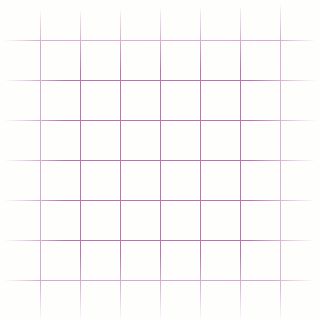 Unlike a chess board, which always has 8 positions in each direction (for a total of 64), this matrix model isn't limited to a particular size. As a way of understanding most common formations, we don't need anywhere near as many as 64 positions.
Unlike a chess board, which always has 8 positions in each direction (for a total of 64), this matrix model isn't limited to a particular size. As a way of understanding most common formations, we don't need anywhere near as many as 64 positions.
But for different formations we need to account for different numbers of spaces, and with some kinds of phantom formations we definitely need to account for more than 8 positions in some direction. For example, if we want to be able to deal with three 4-dancer lines arranged end to end, we need 12 positions in that direction; if we wanted to represent two tidal waves end to end, we would need 16 positions.
So it is best to think of this matrix as potentially infinite, with as many positions in any direction as we happen to need for a particular purpose – we are just making use of a very limited part of it at any given time.
Let's look at how some common formations relate to this model.
Parallel lines of any kind, including parallel waves, facing lines, back to back lines, and so on, are considered to fit into a "2x4" portion of the matrix – four positions wide, and two positions forward and back:
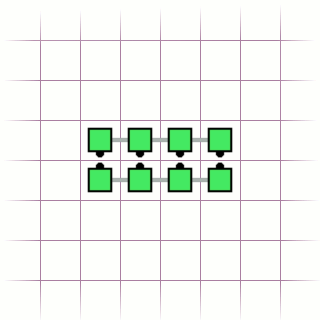
Parallel columns also fit into a "2x4" set of positions, but in this case two positions wide and four positions forward and back. (Both lines and columns could of course equally well be facing head walls or side walls. The size of the rectangle of spots is still described as "2x4" in either case.)
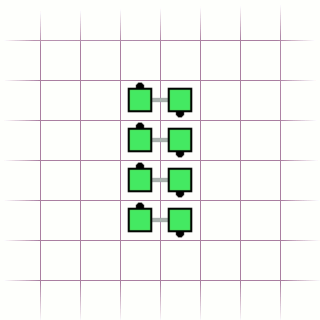
Also note that none of these descriptions of the number of spots has anything to do with the direction that any of the dancers are facing. We are only concerned, in this context, about the dimensions of the rectangle of spots. Parallel waves, other kinds of parallel lines, ordinary parallel columms, the "eight-chain" and "trade by" formations, as well as any t-boned situations where dancers are occupying those same spots, are all considered to be "2x4"s.
A single box is a "2x2":
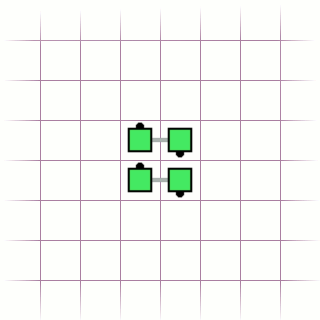
The Triple Box concept tells us to consder a 2x6 set of matrix postions as if they were three boxes. That's a total of 12 spots. When such a set of spots is being treated as triple boxes, of course only 8 of those spots are occupied by actual dancers – the other 4 are considered to be occupied by phantoms.
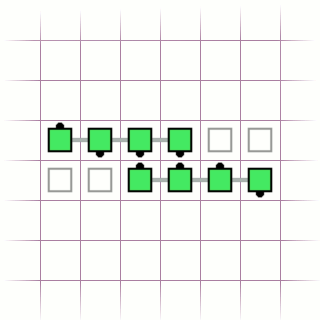
Finally, consider one of the first formations you learned about in beginner class, a squared set. You already know it can be thought of several different ways. It can be used the same way as a circle, for calls like Circle Left and Allemande Left. When we apply the A-2 concept "All 8", we treat it as two intersecting distorted boxes. But for some purposes it is useful to consider squared set spots in terms of matrix positions:

There are some common formations for which the matrix model isn't a good fit. The spacing of the dancers in formations like diamonds and hourglasses doesn't map neatly into a square pattern. Sometimes it is helpful to think of parts of such a formation in terms of the matrix model. And in certain situations we consider some of the postions in such a formation to act as if they were in matrix positions, even though they are not physically spaced that way. But the most common use of the matrix model, and therefore the most common use of calls like Press, is in connection with formations that have a "rectangular" shape – things like lines and columns.
Some Common Cases of Press Ahead
In principle the action of Press Ahead doesn't depend on the current formation.
The caller could even just direct one particular dancer to Press Ahead, turn left or right, do some more Press Aheads, and so on, travelling all around the matrix with no regard to anybody else at all. However, Press Ahead is most often used in connection with certain formations, and so it's helpful to look at those cases. Not only will this help you better understand what Press Ahead means, it also will help you know what kinds of resulting configurations to expect, and avoid making certain kinds of common mistakes.
A very common usage, perhaps the most common usage, is from parallel lines where at least some of the dancers are leaders (facing out). Parallel lines are an example of a "2x4" formation, with eight matrix spots all occupied by actual dancers. If the caller directs any of the leaders in those lines to Press Ahead, they will be moving forward into postions that are not part of that 2x4 group. The result will be an expanded set of positions, a set that is still four positions from side to side but now there are four possible positions front to back.

Note that if there are four possible positions from side to side and four possible positions from front to back, that's a total of 16 possible positions. And even though there will only be actual dancers in half of those possible positions (because there are only eight actual dancers), it is still useful to consider all of those possible postions together as a set, and such a set of positions is typically referred to as a "4x4".
To take a more specific example, if just the ends Press Ahead, the eight dancers will then be in "Butterrfly spots":

If just the centers Press Ahead, the eight dancers will then be in "O spots":

If every other dancer does a Press Ahead (e.g., if from parallel waves the caller said "Leaders Press Ahead", or if from back to back lines the caller said something like "Beaus Press Ahead"), the eight dancers will then be in "Block spots".

Note that if there are dancers in parallel lines who are facing each other, a Press Ahead will take them into each other's spot, In this case, Press Ahead has the same effect as Pass Thru (or Circulate). And you should dance it the same way, by passing right shoulders. Depending on the facing directions of other dancers in the lines, the overall result might be something like lines back to back, a Butterfly, or something completely different. (But starting from parallel lines it will always be something that fits within a 4x4 set of matrix positions, at most.)

From ordinary right- or left-handed parallel columns, a common usage is everybody Press Ahead. (The caller doesn't need to say "everybody" – just "Press Ahead" would have the same meaning.) The result may be surprising at first, because even though each dancer only moves forward one spot there is an offset of two positions in the resulting configuration. Look at animations, or put eight pennies or squares of paper or whatever on a table and move them yourself, to see how this happens. Do that now, to be sure you understand it! Because as a practical matter, after you have done it a hundred times you will come to expect it and you will no longer wonder about it.

1/2 Press Ahead
Note that in a 2x4 formation, such as parallel lines or columns, there are no dancers standing on either "axis" line going through the very center of the square. There are four dancers standing on one side of the center line, and four dancers standing an equal distance away from the center line in the other direction. That's because, in each direction, there are an even number of positions. If we apply Press Ahead to dancers who are part of such a formation, they will never end up on a center line – that's simply not one of the possible spots in the matrix.
But that's not true of all formations. Consider a tidal wave, which in matrix terminology is a "1x8". There are an even number of spots along the length of it (8, so it can be divided into two groups of 4 in that direction). But in the other direction is it only one spot wide – and in this case the dancers are standing directly on a center line (the "long axis").
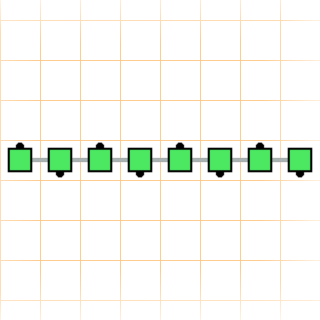
Or consider "triple waves", which in matrix terminology occupy a "3x4". The center wave is standing directly on one axis. The other two waves are offset by one spot from that axis.
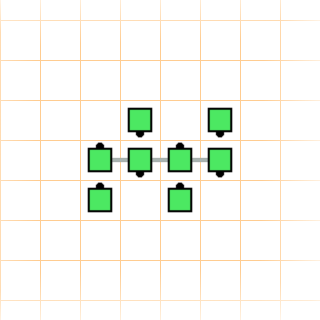
How does this formation fit into the matrix model? We can still use the same basic idea to think about such a formation, but we need to think of a different set of potential spots. These matrix spots still have the same basic properties – they still form a square grid, with even spacing in both directions, and potentially extending as far as we want in every direction. The only difference is how this set of spots aligns with the center line of the square – with one row of positions being exactly on a center line.
Moving among these matrix positions with Press Ahead works the same way, just move forward to the next position. But with this set of matix positions, no matter how many times you do a Press Ahead you will never find yourself in one of those spots we were looking at earlier, the ones that you could get to from parallel lines.

It's almost like there are two separate matrixes, overlapping with each other in the same physical space! And you can think of them that way if you like. But we do want to be able to move between them. Notice that the spacing of the spots in each matrix is uniform, and the same in both of them. But the two sets of spots are offset from each other by exacty half that distance. So if we did just half of a Press Ahead,we would find ourself in the other matrix.
Here's a very common example. From parallel waves (a "2x4"), all 1/2 Press Ahead. The result is that instead of 2 rows of possible dancer positions there are now 3 such rows, for a total of 12 possible dancer positions. This is a situation where the caller might then want to apply the Triple Waves concept. But whatever the caller ends up doing with them, we can see that the "2x4" has now turned into a "3x4" – an even number of rows (in the forward and back direction) has turned into an odd number.
In general, that's what you should expect to happen when 1/2 Press Ahead is used. The dancers will move from the matrix that is useful for modeling formations with an even number of rows into the one that is useful for modeling formations with an odd number of rows (or the other way around). In contrast, if you do a full Press Ahead, you will stay in the same matrix.
Understanding this principle can be very helpful in avoiding common mistakes. Some dancers find it diffcult, when starting in a formation that has a lot of empty space, to know how far to walk forward on a Press Ahead. For example, starting from Triple Lines with the dancers in the outer lines facing inward, it is a very common mistake for the dancers to stop too soon, especially if there is somebody with whom they can easily take hands. And so, on a Press Ahead they may try to form parallel waves.
But this cannot be correct, because triple line spots fit into a 3x4 matrix, and parallel lines are represented by a 2x4 set of matrix spots. And as we have seen a full Press Ahead cannot change a set of spots from one with an odd number of rows to one with an even number of rows. The correct result has to be something else with an odd number of positions along that dimension. (In this kind of case it will normally be another set of spots that can be treated as Triple Lines.)
Differences from Other Kinds of Forward Motion
There are several other kinds of actions in square dancing that involve the idea of "moving forward". It is very important to understand each one, and not get them confused with each other. We have already mentioned Circulate – in which the moving forward happens along a "circulate path", and Extend – in which the moving forward is done to the next tagging position. Another is the action of "stepping thru", which is what happens at the end of calls like Pass Thru, Turn Thru, Square Thru, and all the calls which have those kinds of actions as their last part.
It can be easy to forget that these kinds of actions are all different, at a conceptual level, because sometimes they turn out to involve the same physical action, at least for some dancers. But in general they will involve a somewhat different ending position, and you really need to understand the differences to be able to execute the related calls correctly.
So, a good first step in getting all this right is to review those other kinds of actions:
- Circulate
- Extend
- Step Thru
Re-read the relevant definitions. Look carefully at diagrams and animations, and try to understand how far the dancers move forward, whether they also have to move sideways, and why these details matter.
There is a nice set of diagrams showing the difference between Press, Extend, and Step Thru from parallel waves on the Ceder page for Press.
A Few Extensions of this Idea
Press can also be followed by a direction, e.g., "Press Left". This does not mean to step sideways – it means to step forward one position and also move one position to the left. This usage of Press is defined as part of C-2, but you may also sometimes hear it at C-1. (One reason is that it used to be part of C-1.) In additon to "Left" and "Right", the directions "In" and "Out" are also used in this way.. For example, "Press Out" means to move diagonally one position forward and one position sideways away from the center of the set.
Occasionally a caller may say "Press Back". This means to move directly backwards one matrix position. Many callers consider this a "gimmick", but you may hear it and that's what it means.
Press is also sometimes used in combination with concepts that could modify the amount that you need to move. Specifically, the combination "Tandem Press Ahead" means that you should consider each pair of dancers that form a tandem to be "one dancer", occupying one "tandem spot", and move forward to the next tandem spot. But in order to do that each individual dancer will be moving forward two individual dancer spots.
 The "spots" we need to understand here are different ones, and in a way much easier to understand. They are the positions in a uniform "matrix" of positions, equally spaced like those on a chess board. The action of "Press Ahead" is simply to move forward, to the next one of those little squares, in the direction that the dancer is currently facing.
The "spots" we need to understand here are different ones, and in a way much easier to understand. They are the positions in a uniform "matrix" of positions, equally spaced like those on a chess board. The action of "Press Ahead" is simply to move forward, to the next one of those little squares, in the direction that the dancer is currently facing.
 Unlike a chess board, which always has 8 positions in each direction (for a total of 64), this matrix model isn't limited to a particular size. As a way of understanding most common formations, we don't need anywhere near as many as 64 positions.
Unlike a chess board, which always has 8 positions in each direction (for a total of 64), this matrix model isn't limited to a particular size. As a way of understanding most common formations, we don't need anywhere near as many as 64 positions.













